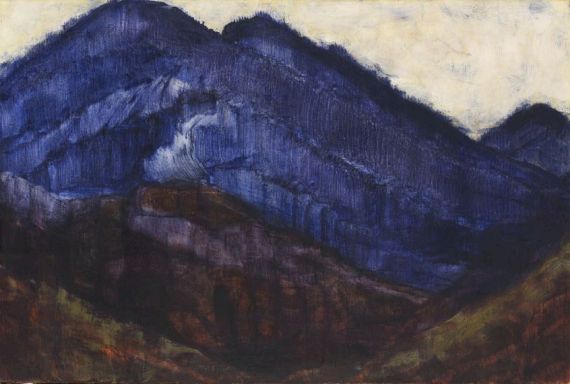412
Christian Rohlfs
Die blauen Berge, Um 1912.
Oil on canvas
Estimate:
€ 60,000 / $ 70,800 Sold:
€ 118,750 / $ 140,125 (incl. surcharge)
Die blauen Berge. Um 1912.
Oil on canvas.
Vogt 527. Lower right monogrammed. 80 x 120 cm (31.4 x 47.2 in).
• From the renowned collection of Adalbert and Thilda Colsman, Langenberg.
• Made during the artist's first stay in Bavaria.
• Despite the fact that the artist rendered the blue mountains true to nature, the composition has an almost abstract appeal and the color comes to the fore.
PROVENANCE: Collection Adalbert und Thilda Colsman, Langenberg (Colsman family-owned until 2016: Grisebach).
Private collection Northern Germany (acquired from the above in 2016).
EXHIBITION: Christian Rohlfs. Göttingen, Kunstsammlungen der Universität Göttingen, 1949, cat. no. 25/ Freunde des Museums sammeln. II: Kunst aus der ersten Hälfte des 20. Jahrhunderts. Essen, Museum Folkwang, 1972, cat. no. 54, illu. on p. 59.
LITERATURE: Villa Grisebach, Berlin, auction on June 2, 2016, 20 Werke aus der Sammlung Adalbert und Thilda Colsman, lot 15.
Oil on canvas.
Vogt 527. Lower right monogrammed. 80 x 120 cm (31.4 x 47.2 in).
• From the renowned collection of Adalbert and Thilda Colsman, Langenberg.
• Made during the artist's first stay in Bavaria.
• Despite the fact that the artist rendered the blue mountains true to nature, the composition has an almost abstract appeal and the color comes to the fore.
PROVENANCE: Collection Adalbert und Thilda Colsman, Langenberg (Colsman family-owned until 2016: Grisebach).
Private collection Northern Germany (acquired from the above in 2016).
EXHIBITION: Christian Rohlfs. Göttingen, Kunstsammlungen der Universität Göttingen, 1949, cat. no. 25/ Freunde des Museums sammeln. II: Kunst aus der ersten Hälfte des 20. Jahrhunderts. Essen, Museum Folkwang, 1972, cat. no. 54, illu. on p. 59.
LITERATURE: Villa Grisebach, Berlin, auction on June 2, 2016, 20 Werke aus der Sammlung Adalbert und Thilda Colsman, lot 15.
412
Christian Rohlfs
Die blauen Berge, Um 1912.
Oil on canvas
Estimate:
€ 60,000 / $ 70,800 Sold:
€ 118,750 / $ 140,125 (incl. surcharge)
Headquarters
Joseph-Wild-Str. 18
81829 Munich
Phone: +49 89 55 244-0
Fax: +49 89 55 244-177
info@kettererkunst.de
Louisa von Saucken / Undine Schleifer
Holstenwall 5
20355 Hamburg
Phone: +49 40 37 49 61-0
Fax: +49 40 37 49 61-66
infohamburg@kettererkunst.de
Dr. Simone Wiechers / Nane Schlage
Fasanenstr. 70
10719 Berlin
Phone: +49 30 88 67 53-63
Fax: +49 30 88 67 56-43
infoberlin@kettererkunst.de
Cordula Lichtenberg
Gertrudenstraße 24-28
50667 Cologne
Phone: +49 221 510 908-15
infokoeln@kettererkunst.de
Hessen
Rhineland-Palatinate
Miriam Heß
Phone: +49 62 21 58 80-038
Fax: +49 62 21 58 80-595
infoheidelberg@kettererkunst.de
We will inform you in time.




 Lot 412
Lot 412 
